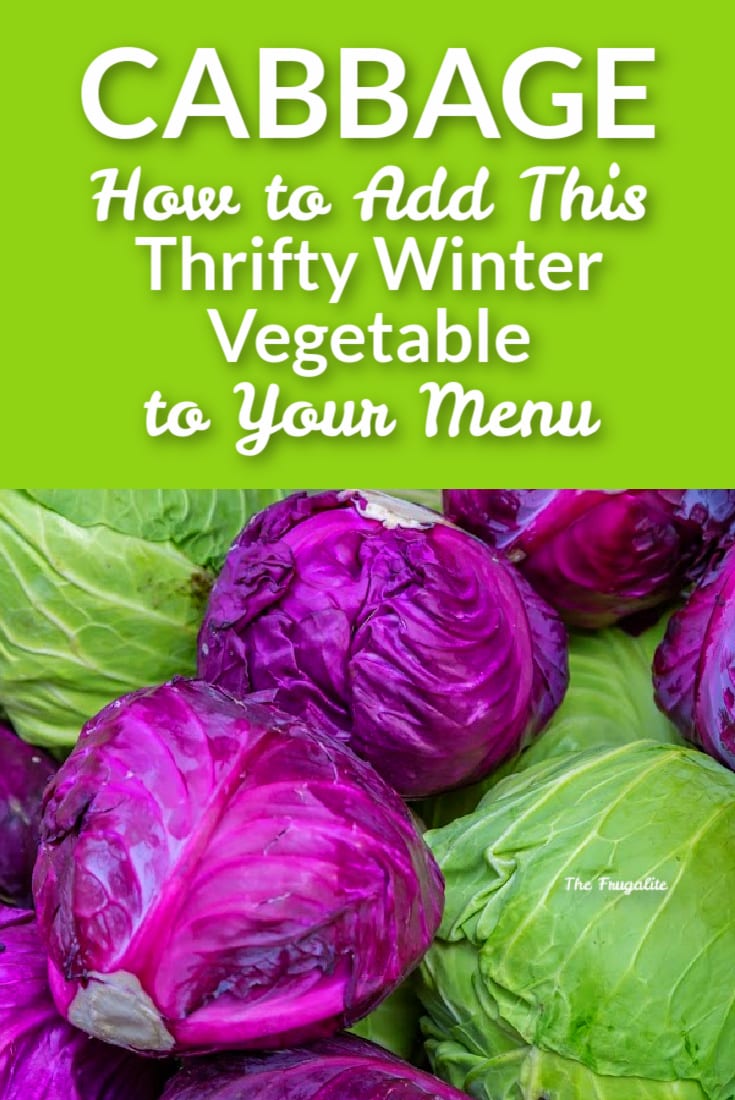(Psst: The FTC wants me to remind you that this website contains affiliate links. That means if you make a purchase from a link you click on, I might receive a small commission. This does not increase the price you’ll pay for that item nor does it decrease the awesomeness of the item. ~ Daisy)
Are you looking for some ways to add more produce to your diet without paying a fortune this winter? Aside from these root vegetables, cabbage is one of the cheapest choices around this time of year, making it a Frugalite’s dream veggie.
In my home, cabbage wasn’t something we ate very often aside from the occasional cole slaw. While I loved that dish (and still do), my sister hated it so it wasn’t frequently on the menu. As an adult, cabbage has become an essential ingredient in many meals. With the average price per pound being a mere $0.62, (making it one of the cheapest vegetables you can buy) it is definitely an affordable vegetable and one that many people don’t take advantage of. Cabbage is a very filling vegetable and full of lots of nutrients like Vitamin A, Vitamin C, Vitamin K, fiber, antioxidants, and so much more.
I, personally, find a way to eat cabbage almost every single day, and it’s added a lot of much-needed servings of vegetables in my daily diet, as well as just bringing a variety and tastiness to my life. Below are some of the simple ways I eat cabbage on the regular.
Sautéed
This is probably my favorite way to eat it. It’s oh so simple, quick, and absolutely delicious! It also makes a great side for almost any meal. Having a roast? A BBQ? A grilled sandwich? Make it a side dish!
All you need for this recipe is;
- 1 tbsp. oil of your choice (My go-to is either olive oil or canola oil)
- 2 cups raw cabbage
- Salt and pepper to taste
And for the super easy steps?
- Heat up a frying pan on medium heat with oil.
- While the pan is heating, cut the cabbage into pieces (I typically go for squares approximately the size of a quarter or a little bigger.)
- Once chopped and the pan is hot, put the cabbage in. Cook for 7-10 minutes, or until cabbage is soft and slightly translucent. Stir frequently.
- Add salt and pepper to taste and serve hot.
What did I say? Super easy, and absolutely delicious! If your feeling adventurous, you can also add in a few sliced onions near the beginning or a little garlic (or garlic powder) in the last 2 minutes. You can also start off cooking one slice of bacon in the pan to give the entire dish a smoky flavor. Often for lunch, I’ll eat about a cup of sautéed cabbage with a cup of rice cooked in broth for a super cheap, filling, and healthy meal. Plus, it heats up in the microwave nicely as well.
Stir Fry
Have you and your family started taking advantage of the cheap and easy meal of stirfry yet? If not, you should start! It’s great, cheap, versatile, flavorful, and completely customizable. We have it at least once a week in my house. As a matter of fact, it’s actually what I’m making for dinner tonight.
The typical stir fry varies a lot, but one of my go-to vegetables in my stir-fry is, can you guess? If you guessed cabbage, you’re right! (That might have been a little obvious given the fact that this whole article is about cabbage.) Anyway, cabbage probably makes up about 1/3 of the vegetables in my stirfry. I also add peppers, zucchini, onion, carrots, celery, mushrooms on occasion (they aren’t my favorite, but everyone else in my house loves them), broccoli, and cauliflower.
While the zucchini, cabbage, onions, carrot, mushrooms, and celery are usually fresh vegetables, I typically will do the rest in frozen vegetables just for the sheer fact that they are more cost-efficient, and have more longevity.
Now, I’ve told you what to put in the stir fry, now the question is, how do you cook it?
Basically, just sautée all your vegetables, cooking the harder ones (carrots and celery), until soft, then adding in the softer ones (peppers, mushrooms, zucchini, cabbage, onions, and frozen vegetables). By doing it this way, you get an even texture across the lot.
Right at the end, add a little store-bought sauce for flavor, or try making your own, and serve over rice. Now, a lot of people like to add things like steak strips or chicken for a little protein, which is great if you do. If that’s the case, just cook your meat in the pan thoroughly, remove it, and cook the vegetables, and put it back in at the end, right before you put the sauce in.
Coleslaw
Now this, I mentioned at the beginning of the article, is one of my favorite ways to eat cabbage, and extremely easy to make. Instead of doing a lettuce or spinach salad, try coleslaw next time! Not only is it delicious, but it’s also a lot more cost-efficient and filling too.
What you’ll need;
- 4 cups thinly sliced or shredded cabbage
- 1 carrot shredded (a regular cheese grater works perfectly for this)
- 1/4 cup onion very thinly sliced (optional)
Take all of the above ingredients, mix together in a bowl, and pour the dressing over, and mix until everything is coated. Serve it nice and cold. (It will stay good in the fridge for about 3-4 days.)
For the dressing, you do have a few options. You can easily buy the store-bought coleslaw dressing (I think they tend to be about $2 a bottle), but if you’re feeling adventurous, you can make your own, which is what I tend to do. Now, this is where you get to have a little fun!
So, the basic formula for a good creamy coleslaw dressing is this simple mixture:
3 tbsp. mayo + 1 tbsp. vinegar + 1 tsp. something sweet + salt and pepper to taste
My go-to recipe is mayo, lemon juice or white balsamic vinegar, brown sugar, and salt, pepper, and garlic powder to taste.
Want some ways to mix it up a bit? Well, let’s start off with the first part of the equation, mayo. This can be subbed for either Miracle Whip or heavy cream. I personally prefer mayo, or miracle whip as it makes the dressing a little thicker, but use what you have.
The vinegar, so, I already told you my two go-to ingredients; lemon juice or white balsamic vinegar. If neither of those appeals to much, they’re easy to swap up. You can also use; white vinegar, balsamic vinegar, lime juice, apple cider vinegar, white wine vinegar, I think you get the idea. Basically, 1tbsp. of something acidic.
And last but not least, the little something sweet. My favorite is brown sugar, but the following work just as well; white sugar, honey, or maple syrup.
Here are just a few more ways to add cabbage to your life.
While I’ve listed my 3 favorite ways to eat cabbage, there are so many more!
- Add it to your soup or stew (Here’s a delicious cabbage soup for home-canning – if you aren’t a canner, you can simply pare down the amounts to make a pot of this tasty soup that even my cole-slaw-hating sister likes.)
- Add it to casseroles (Here’s Daisy’s Ultimate Frugal Casserole Formula.)
- Cabbage rolls (Here’s a simple and inexpensive recipe.)
- Boil it (While you can boil it, I don’t recommend boiling vegetables unless it’s going in a soup as a lot of the nutrients get dissolved into the water.)
- Steam it
- Roast it (This one is super easy – cut it in thick chunks, brush it with a little oil, maybe throw in some garlic, and roast at 350 F for about 25 minutes.)
- Fry it with your morning eggs
- Added to your dish of perogies, and topped with sour cream and cheese
- Corned beef and cabbage is a staple of Irish cuisine. Here’s a recipe.
How do you eat cabbage?
What are your favorite ways to eat cabbage? Will you be adding it to your grocery list this week? Let’s dish about cabbage in the comments.












13 thoughts on “Cabbage: How to Add This Thrifty Winter Vegetable to Your Menu”
As the author mentioned roasting, I will just add: if you’re not a fan of cabbage yet, try a purple cabbage, sliced into 1/6th wedges, roasted, with olive oil and a sprinkle of seasoned salt on top. I would be very surprised if you didn’t like it, after that – I’m not a fan, myself, but I can go through a whole head of it in a couple of days, prepared like this!
That sounds delicious! I’ve never roasted my purple cabbage before. I’ll have to try it tonight with dinner 🙂
Cabbage rolls… Yum
Or make into a casserole with hamburger, cabbage and tomatoes. Quick and lazy way…
We should try more cabbage as it is a good storage veggie.
Yum! That sounds like a tasty casserole. Might just have to try that for dinner this weekend.
Cabbage, onion, tomatos can go with ANY meats, esp. if they are flavored. My 2 favs are kielbasa or bacon
Love it in all ways. But my absolute favorite is in Jigs Dinner. Great article by the way.
I’ve never done a proper Jiggs dinner before. I’ll have to give it a try. And thank you!
Yay cabbage! I like cutting it in thin strips and scrambling with eggs (partially mentioned above) and I also like putting strips of it into a regular salad. Another fun thing to do is put some in with ramen noodles, Thai noodles, or pho. Finally, and perhaps most delicious of all, you can make sauerkraut!
Ooo, I’ve never tried it with my ramen, Thai, or pho before. That sounds really tasty
Thinly sliced or shredded and put on top of a sandwich! Nice cool crunch!
Thanks for posting this. Going to try eating more of this vegetable. Mom always cooked Ham and Cabbage when we were young. I tried making my own coleslaw but failed, ate it anyway. Will try some other ways to eat it.
Try using one of your favorite salad dressings on your cole slaw. See if you like it like that. Sometimes I don’t feel like making the dressing for it so I use ranch, italian or thousand island. Gives it a different taste
I make Haluski on a regular basis
I also use shredded raw cabbage as the base for my salads instead of lettuce